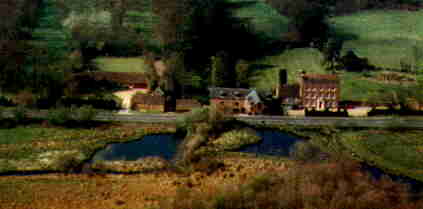 Bishop's
Waltham in the County of Hampshire.
Bishop's
Waltham in the County of Hampshire.Waltham Chase Mill
Waltham Chase Mill stands in rural surroundings in the South
of England, about 0.5 kilometres from  Bishop's
Waltham in the County of Hampshire.
Bishop's
Waltham in the County of Hampshire.
Waltham Chase Mill is a unique twin pitchback Victorian watermill, which was built to provide flour and animal feed for the local community; its grain bins stored about 400 tons of grain. The mill is largely Victorian and dates from about 1830, but there are many parts of the building dating back much before this.
The mill site, seen here the north with the millpond in the foreground, is mentioned in the Doomsday Book (1086) and there has probably been a mill on site for considerably longer than this, perhaps for 1000 years or more. The Doomsday Book mentions an annual levy on the mill of 10 hides, and records 70 villagers. The mill was valued at this point at £30. The 1841 census makes it clear that the mill was a major local employer; at least 22 people can be identified that made their living directly from the mill.
From about 1910 the mill only produced animal feed; it ceased milling in 1955. The machinery was built by Armfield, a well-known local manufacturer, and may be regarded as the pinnacle of waterwheel development; turbines and steam took over shortly after this. The mill has two, Armfield pitchback water wheels fed from a single launder. Each water wheel powers two millstones, which are French Burr stones from the Brittany area.
Waltham Chase Mill is extremely unusual in the fact that it has
never been "improved"- converted from water to gas or steam power;
it is an untouched example of a Victorian watermill. This is because it is fed
from natural springs that never dry up, and also because due to the relative
economic decline of Bishop's Waltham at the end of the 19th century it was always
big enough to supply local demands. The springs that feed water to the mill
lie within 200 metres of the mill, and due to their unique flora and fauna The
Moors are a Site of Special Scientific Interest (SSSI).